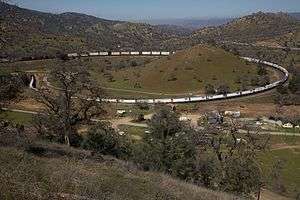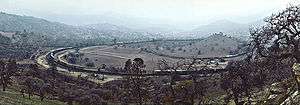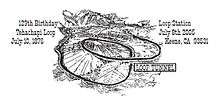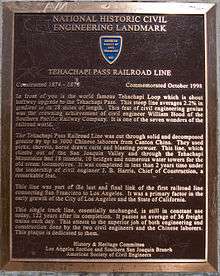Tehachapi Loop





The Tehachapi Loop is a 0.73-mile (1.17 km) long spiral, or helix, on the Union Pacific Railroad Mojave Subdivision through Tehachapi Pass, of the Tehachapi Mountains in Kern County, south-central California. The line connects Bakersfield and the San Joaquin Valley to Mojave in the Mojave Desert. The line, which sees an average of almost 40 trains each day, is one of the busiest single-track mainlines in the world.
With its frequent trains and spectacular scenery, the Loop is one of the prime railfan areas in the country. In 1998, the Loop was named a National Historic Civil Engineering Landmark and is designated California Historical Landmark #508.[1]
History
One of the engineering feats of its day, the Loop was built by Southern Pacific Railroad to ease the grade over Tehachapi Pass. Construction began in 1874, and the line opened in 1876.[2] Contributors to the project's construction include Arthur De Wint Foote and the project's chief engineer, William Hood.[3]
Rising at a steady 2% grade, the track gains 77 feet (23 m) in elevation in the Loop.[4] A train more than 4,000 feet (1,200 m) long passes over itself going around the loop. At the bottom of the loop, the track passes through Tunnel 9, the ninth tunnel built as the railroad worked from Bakersfield.
The siding on the loop is known as Walong after Southern Pacific District Roadmaster W. A. Long.[5][6]
A large white cross, "The Cross at the Loop", stands atop the hill in the center of the loop in memory of two Southern Pacific Railroad employees killed on May 12, 1989, in a train derailment in San Bernardino, California.[2]
A railroad museum stands in the nearby town of Tehachapi.
Operations
The Loop became the property of the Union Pacific in 1996, when it absorbed the Southern Pacific. Trains of the BNSF Railway also use the loop under trackage rights. Union Pacific bars passenger trains from the line, which prevents Amtrak's San Joaquin train from serving Los Angeles (passengers instead must board Amtrak Thruway Motorcoaches to connect from Bakersfield to Los Angeles). This has been the case since the creation of Amtrak in 1971. An exception is made for the Coast Starlight, which uses the line as a detour if its normal route is closed.[7]
See also
- Spiral (railway) for many other loops.
References
- ↑ "Tehachapi Loop". Office of Historic Preservation, California State Parks. Retrieved October 7, 2012.
- 1 2 "Tehachapi Loop history". Tehachapi_online. Retrieved December 1, 2011.
- ↑ Rickard, Thomas Arthur (1922). Interviews with Mining Engineers. San Francisco: Mining and Scientific Press. p. 172. OCLC 2664362.
- ↑ Ande, Howard (2010). "Tehachapi in the 21st Century". NRHS Bulletin. National Railway Historical Society. 75 (Spring 2010): 4–21.
- ↑ Jenkins, Jim C. & Jenkins, Ruby Johnson (1995). Exploring the Southern Sierra, West Side. Wilderness Press. p. 23. ISBN 0-89997-181-4.
- ↑ Durham, David L. (1998). California's Geographic Names. Quill Driver Books. p. 1124. ISBN 1-884995-14-4.
- ↑ "Passenger trains will be diverted over Tehachapi Loop". Tehachapi News. 1 March 2013.
External links
| Wikimedia Commons has media related to Tehachapi Loop. |
- New aerial video of the 2nd track improvement, Nov 2016
- Aerial video of 4000' train going uphill through the loop Nov 2015
- Trainweb.org: Tehachapi Loop - Map and Railfan Info
- Tehachapi Loop - A Brief History
- Tehachapi Loop Photos
- Photo Gallery of Tehachapi Loop shots
- HO Scale Model at the San Diego Model Railroad Museum
- Stay In The Loop - Tehachapi News & Entertainment
- Aerial video of BNSF train traversing Tehachapi Loop
Coordinates: 35°12′03″N 118°32′13″W / 35.20083°N 118.53694°W